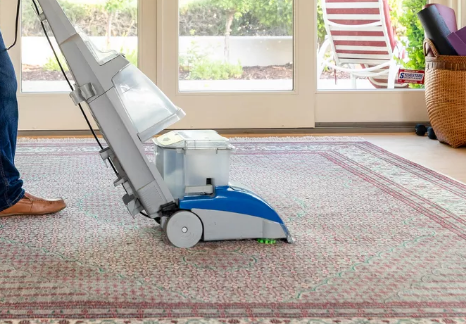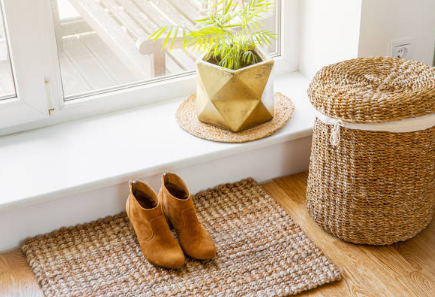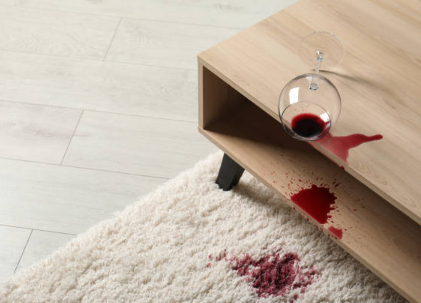Area rugs add a decorative touch to the room, help define the space, and add warmth underfoot. Whether they’re made of wool, natural grass, or synthetic fibers, they ultimately need to be cleaned. Cleaning small rugs on any type of floor, including hardwood floors, floor-to-wall carpets, and tiles, is a bit more complicated than just cleaning where the rug is. Protecting the floor underneath, especially hardwood floors (which can be easily damaged) and carpets (which can absorb water or detergents and does not dry properly), is just as important as cleaning the carpet properly.

How Often to Clean Your Rug
Carpets should be vacuumed at least once a week, preferably several times a week, to prevent dust and dirt from penetrating deeper into the fibers and lifting tangled fibers. If the sand and dirt get deep into the fibers, the backing can be damaged, and if they do, even the hardwood underneath can be scratched.
Liquid spills and pet accidents must be cleaned up immediately. Moisture can penetrate the floor through the carpet and the protective pad underneath. Moisture can trap and, depending on the floor underneath, leave watermarks on the wood that are difficult to remove or stain the wall carpet underneath the carpet.
Carpets in each area should be thoroughly cleaned at least twice a year, and more frequently if there is a lot of traffic.
What You’ll Need

Equipment/Tools
- Soft bristle brush
- vacuum
- Small Bowl
- Microfiber cloth
- plastic tarpaulin or cloth
- Sponge mop
- Old bath towels
- Steam cleaner
Material
- Sodium bicarbonate
- Dishwashing liquid
- Oxygen bleach
- Carpet stain remover
- Carpet shampoo
How to Clean a Rug
01. Vacuum the Dirt

Whether you’re ready for a thorough cleaning or just daily care, vacuum your carpet with a carpet stirring bar to loosen and suck up dirt. If the carpet is small enough, vacuum the top and turn the carpet over to vacuum the underside.
If possible, take the mat outside, give it a good shake, and dust the floor under the carpet with a vacuum cleaner or mop mop.
Tip: When you clean your carpet thoroughly, remember to remove the protective pad underneath the carpet and clean it.
02. Spot Clean Stains

For small stains, place a plastic tablecloth or placemat under the affected area on top of the carpet mat. This will protect the floor underneath from moisture.
Many types of stains, especially dirt and food stains, can be removed by doing a spot cleaning with a solution of one teaspoon of dish soap mixed with two cups of warm water. Use a soft-bristled brush to apply the solution to the stained area. Let it work for about 10 minutes, then wipe off dirty water and stains with a clean cloth.
Soak a clean cloth in fresh water and dry the area to rinse off any excess soap solution.
If the stain is still visible, mix the solution of warm water and oxygen bleach as directed on the product label. Apply directly to the stained area and leave it on for one to two hours to gently fade the stain.
To speed up drying after spot cleaning, elevate the cleaned carpet area with a book or plastic bowl to increase air circulation.
03. Remove Odors from Carpets

To brighten the carpet and remove odors, sprinkle baking soda over the entire surface. If the fluff is long or plush, use a sponge mop to gently dip the baking soda into the fibers and backing.
Let the baking soda sit on the carpet for a few hours – preferably overnight – and vacuum it off. Baking soda absorbs odors, and its mild, abrasive properties loosen dirt that needs to be vacuumed.
04. Prepare the Space for a Thorough Carpet Cleaning

If the carpet needs to be cleaned thoroughly and cannot be moved to an area with vinyl, tile, or stone floors, the hardwood or carpet must be protected.
- Vacuumize the carpet.
- Roll up the area rug and move it to one side.
- Roll up the carpet mat and move to the side.
- Remove dirt, dust, and grit from the floor with a vacuum cleaner or dry mop.
- Spread a plastic tarp or plastic sheeting on the floor that is larger than the carpet. Secure the plastic with masking tape.
- Lay the area carpet on top of plastic sheeting.
05. Clean with Carpet Shampoo and Mop

Read the label on the carpet shampoo to determine if it must be diluted or can be used directly from the bottle.
Apply the shampoo with a sponge mop or a soft-bristled brush. Use enough liquid to completely wet the carpet, but not too much so that it doesn’t oversaturate.
Use a brush in heavily soiled areas to loosen the soil.
Finally, the mop is immersed in fresh water and the fibers are rinsed to remove soap residue. Change the rinse water frequently until no more dirt or foam appears.
06. Clean with a Carpet Steamer

Once the room is ready, the area carpet can be cleaned using a home or rented carpet steamer. Follow the instructions and use an approved cleaning solution recommended by the steamer manufacturer.
Tip: If the carpet has tassels, it should be cleaned by hand with a solution of dish soap and warm water using a sponge or microfiber cloth. Treat only a small portion at a time, and after cleaning the area, rinse with fresh water and blot dry with two clean towels. When you’re done, let the bangs air dry, then straighten the fibers with a wide-toothed comb or fingers.
07. Dry the Cleaned Carpet

Open windows, turn on ceiling fans, or add circulating fans to the area to increase airflow and speed up drying. When the surface feels dry, turn the rug over and let the backing dry.
Depending on the size of the carpet, it can be dried for up to 48 hours. You have to be patient and make sure that the carpet is completely dry before putting it back on the floor.
08. Put the Rug Back in Its Original Position

Once the carpet is completely dry, it’s time to reverse the steps.
- Roll up the clean rug and move it to one side.
- Remove the plastic sheeting from the floor.
- If possible, take the carpet mat outside and shake it well.
- Replace carpet mats.
- Replace the area carpet on the mat.
09. Lift the Carpet Pile

Once the rug is back in place, vacuum thoroughly to lift and smooth out the carpet lint.
How to Clean a Small Rug on a Hardwood Floor
01. Be Extra Careful
Hardwood floors are particularly susceptible to scratches and stains from cleaning fluids. To avoid damage to the floor, take extra care when cleaning the carpet.
02. Vacuum and Shake
Vacuum the carpet surface to remove dust, hair, and other grit. If the carpet is small enough to move, flip it over and vacuum the underside. Also vacuum the carpet mat and the hardwood floor underneath.
Tip: When you move the carpet for cleaning, check and clean the hardwood floor underneath as well.
03. Spot Clean and Provide Extra Protection
When it comes time to spot clean your carpet, make sure the barrier between the carpet and hardwood floors is thick enough to prevent moisture from seeping in.
04. Prepare a Thoroughly Cleaned Space
If your area carpet needs to be cleaned thoroughly and cannot be moved to an area where the floor is more durable, vacuum it, roll it up, and carefully cushion the carpet. Use a vacuum cleaner or dry mop to remove dirt and grit that can cause scratches.
When the carpet is wet, lay down and secure a thick plastic sheeting to protect the hardwood floor. Use a carpet cleaner or carpet steamer to clean the carpet and do not replace the carpet until it is completely dry.





